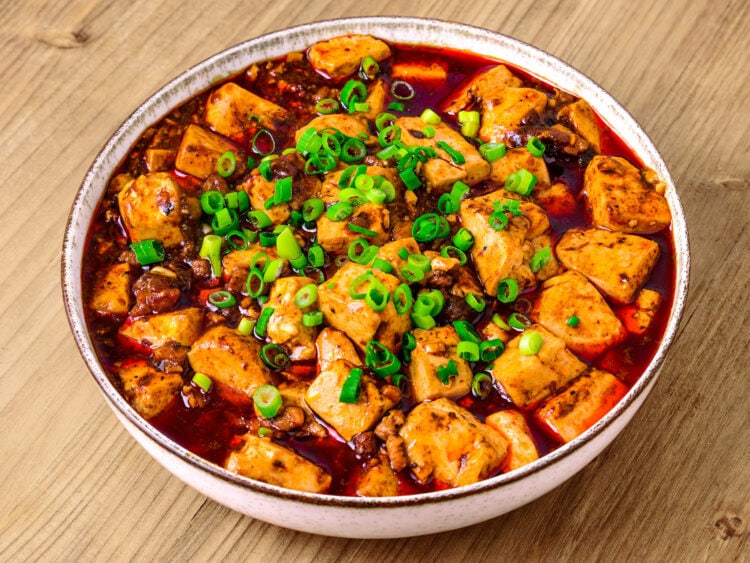A Delicious Mapo Tofu Recipe, Guaranteed to Take You on a Journey Without Leaving Your Kitchen
What Is Mapo Tofu?
Mapo Tofu is a famous Chinese dish originating from Sichuan province, known for being the spiciest of Chinese cuisines. Sichuan pepper, the region’s signature spice, gives dishes a unique “numbing” effect called Mala.
This particular characteristic of Sichuan pepper is not limited to its aroma and flavor; it also serves to numb the tongue, allowing for better tolerance of the dish’s spiciness.
Although its origins are unclear, Mapo Tofu has far exceeded the borders of Sichuan to conquer the world. The dish has been adapted in multiple ways by restaurants and families, who have often reduced its spice level, added various vegetables, and transformed the dish into a new version.
In this recipe, I aim for the traditional and authentic version of Sichuan Mapo Tofu.
Based on the excellent video of the bloggers “Chinese Cooking Demystified”, this recipe is amazing. A spicy and creamy sauce coats cubes of tofu, flavorful bits of ground pork, green onions, and Sichuan peppercorns, creating a harmonious blend of textures and flavors.
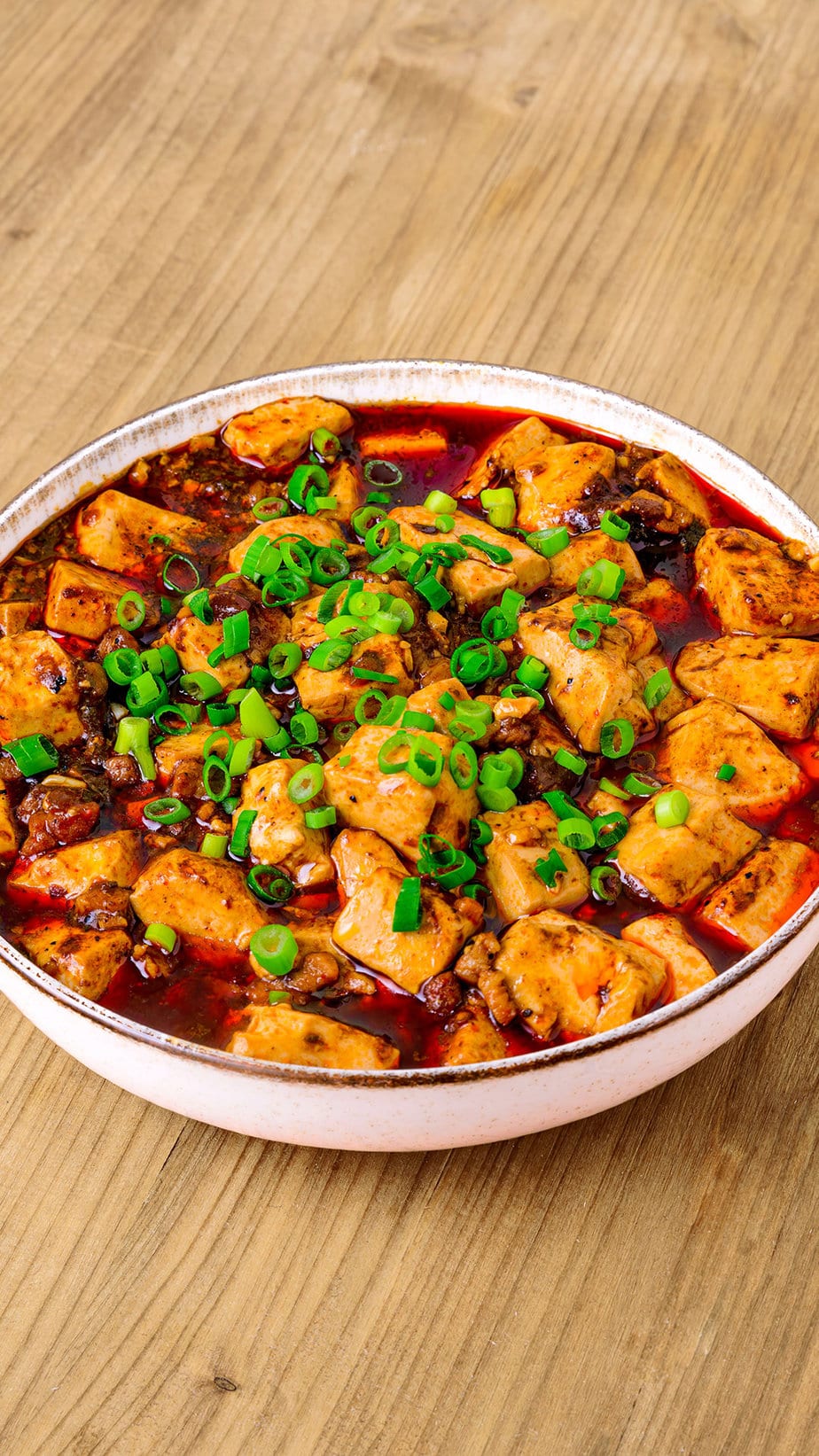
Tips for Successful Mapo Tofu
What Kind of Tofu to Use?
When preparing Mapo Tofu, choosing the right type of tofu is of utmost importance. A common mistake is using an unsuitable tofu. In China, you’ll find “nen doufu” (嫩豆腐), which is contrasted with “neizhi doufu” (内酯豆腐), the latter being a silken tofu that disintegrates easily and is often used in desserts.
Outside of China, you’ll probably find what’s called “soft tofu”, sometimes referred to as “firm silken tofu”, which can be confusing. If you’re unsure when comparing tofu at the supermarket, opt for an appropriate “soft tofu”. A tofu that’s slightly too firm is far preferable to one that’s too soft. If you’re in an Asian supermarket, ask the sellers for tofu suitable for Mapo Tofu.
Regarding the cooking of tofu, it should be cut into small cubes and blanched in simmering salted water. This process has three advantages: it firms up the tofu, eliminates its grassy taste, and lightly seasons it. After removing it from the heat, let it soak until ready to use.
The Spicy Bean Paste
It’s important to note that different brands of doubanjiang (Sichuan spicy bean paste) have varying levels of saltiness, with lower quality brands generally being saltier. This variation can affect the taste of recipes using this ingredient, such as Mapo Tofu and Shuizhu Beef. Before starting to cook, it’s essential to select a “Pixian” type doubanjiang, specific to Sichuan cuisine, and taste it beforehand. If its saltiness is comparable to soy sauce, it can be used as is in the recipe.
If the doubanjiang is excessively salty, reduce the amount from 1.5 tablespoons to 1 tablespoon.
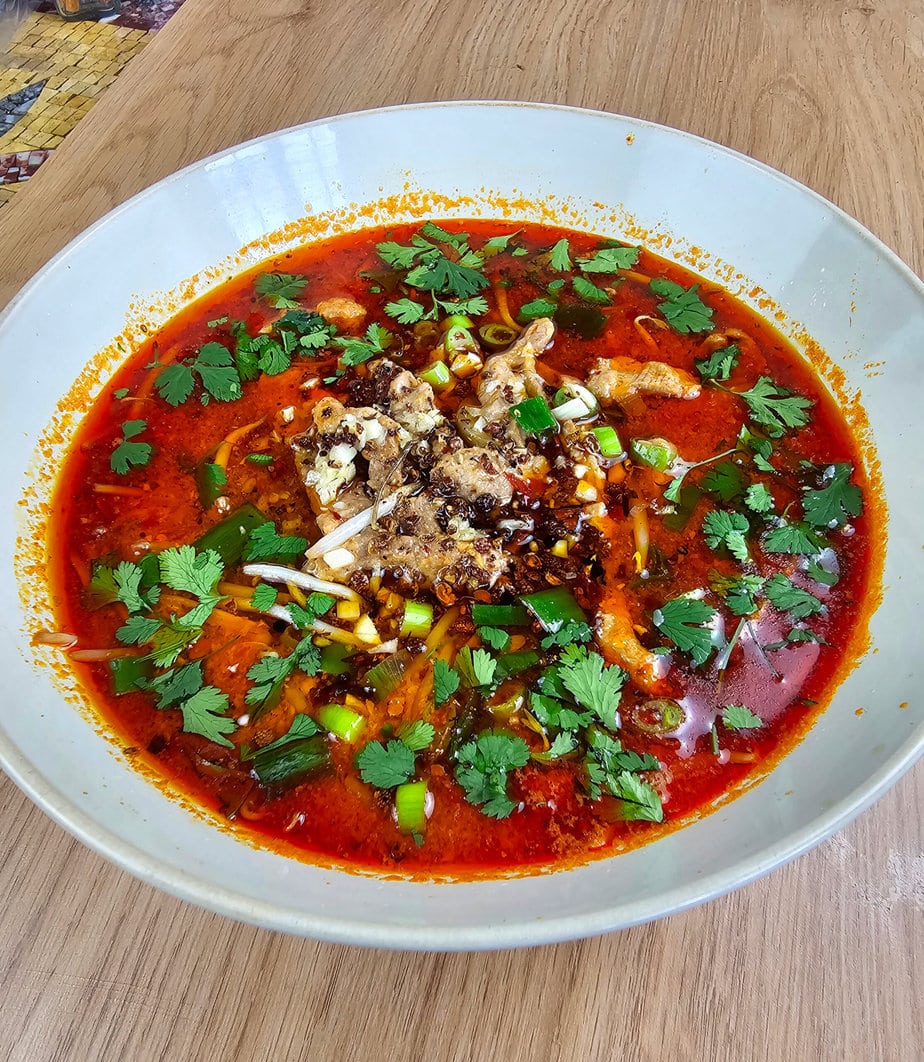
The Pepper and Chili
First, the treatment of Sichuan pepper is crucial. Toast it over medium-low heat in a dry wok until it becomes aromatic and releases small drops of oil. This step enhances its flavor and numbing power. Then grind it, either with a mortar and pestle or a coffee grinder.
This powder will be added towards the end of cooking to preserve its color and potency. For chili powder, feel free to opt for milder varieties depending on your spice tolerance.
The Meat for Mapo Tofu
It’s important to understand the philosophy behind using meat in this dish. It’s not meant as a topping, but as seasoning for the broth. So don’t triple the quantity out of greediness, as it might alter the dish’s nature. However, feel free to increase the amount of garlic shamelessly, hehe.
Whether it’s pork or beef, the meat must be cooked carefully. Use the “reguoliangyou” method (very hot wok, cold oil, and add the meat directly) to separate the meat well with a spatula. If using beef, opt for a very fatty cut and be sure to adjust the amount of oil based on its fat content. The risk is that it might absorb all the famous oil I’ll talk about next.
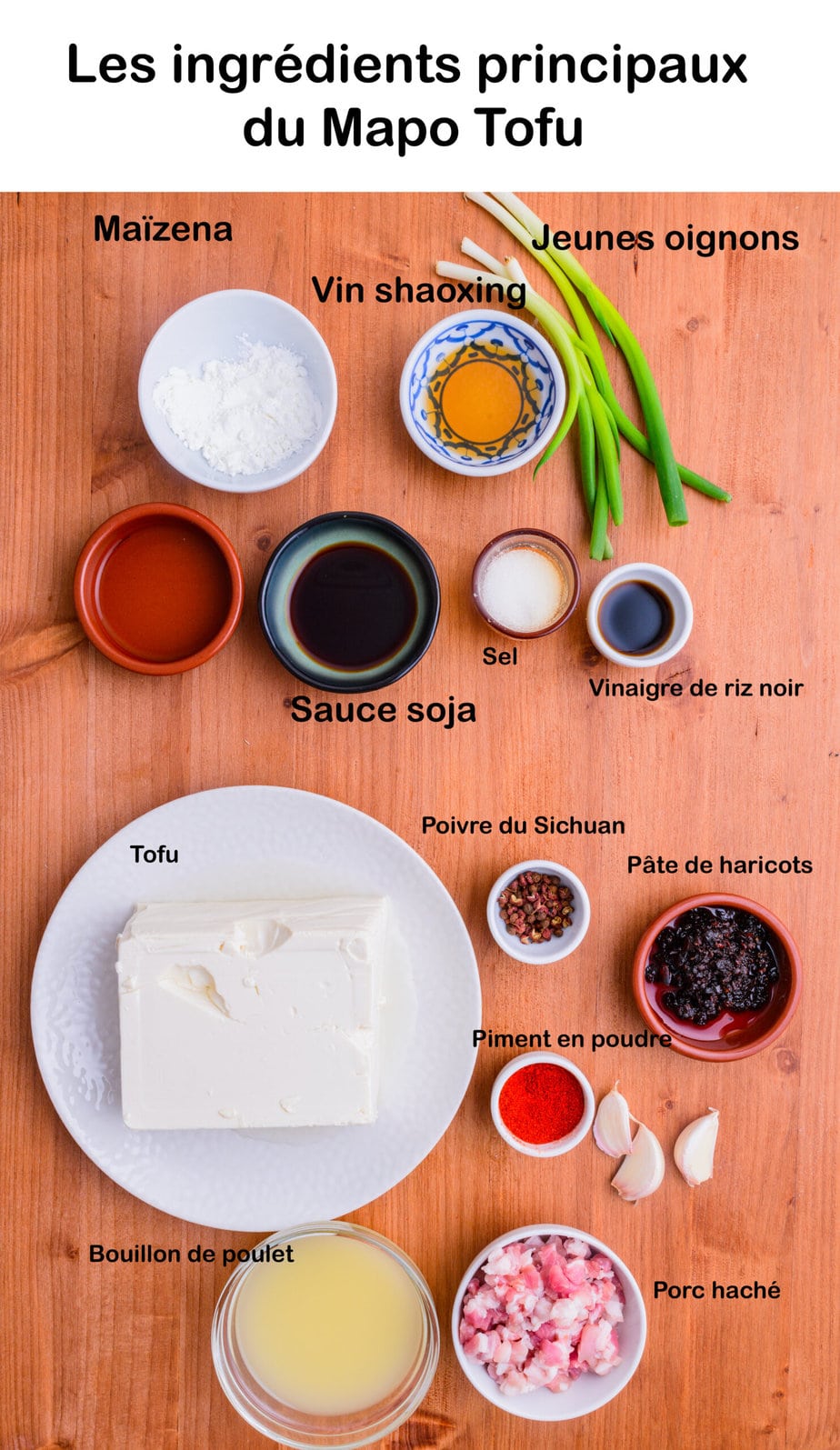
The Red Oil of Mapo Tofu: Hongyou
The distinctive element of Mapo Tofu is the hongyou
, the characteristic red oil of Sichuan cuisine. It’s obtained by frying the spicy bean paste with the minced meat. It’s important not to burn this paste while ensuring the oil is well infused.
For those who have difficulty obtaining “hongyou” with pre-packaged meats, which are sometimes drier and less fatty, try massaging a bit of water into the meat before frying it, or opt for freshly ground meat.
The Crucial Finishing Touch
When you add the broth, soy sauce, Shaoxing wine, and sugar, taste and adjust the seasoning. The broth should be slightly less salty at this stage. After adding the tofu, let it simmer and reduce the sauce until it reaches a slightly thick consistency.
Finish with black vinegar and finally, thicken it with cornstarch. If you find the sauce is too liquid, don’t worry. After serving the tofu, let the red oil rise to the surface and use it to baste the dish. If, on the contrary, the sauce is too thick, add a little water to adjust it.
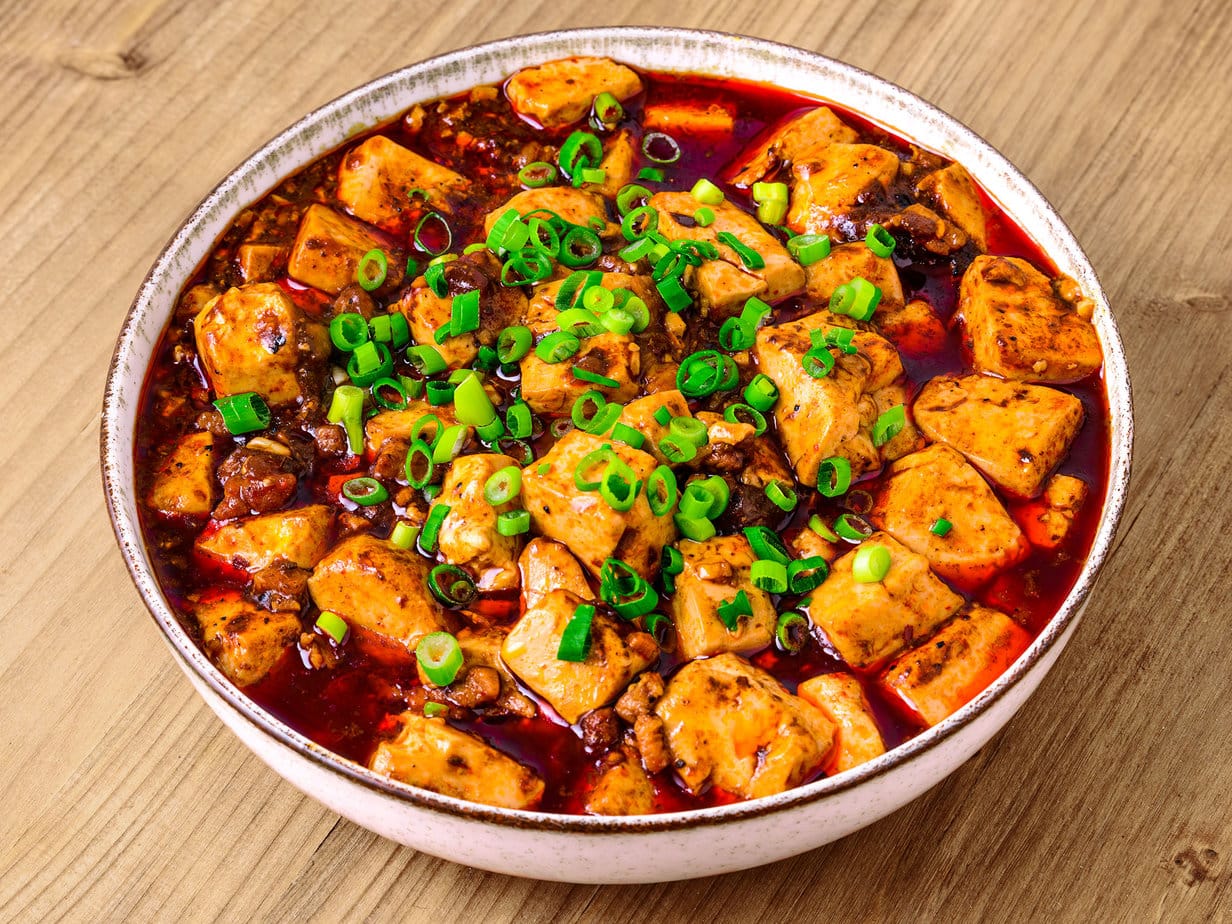
Authentic Mapo Tofu – 麻婆豆腐
Equipment
- 1 Wok
Ingredients
Base
- 230 g of Soft Tofu
- 0.5 tablespoon of Sichuan Peppercorns
- 35 g ground pork 30% fat content
- 4 Cloves garlic Finely Minced.
- 1.5 tablespoon of Sichuan Chili Bean Paste (Doubanjiang) Chopped to Break Down the Bean Pieces.
- 1 teaspoons Chili powder Adjust According to Spice Tolerance.
- 100 ml of Chicken Broth
Other Ingredients
- 1 teaspoon shaoxing wine
- 1 teaspoon light soy sauce
- 1 teaspoon of Sugar.
- 0.5 teaspoon black rice vinegar
- 1 teaspoon cornstarch Dissolved in an Equal Number of Tablespoons of Water
Finishing
- 1 teaspoon of sesame oil
- Chopped Green Onions
Instructions
- Toast the Sichuan Peppercorns in a Dry Wok over Medium-Low Heat. Once Aromatic, Grind Finely.
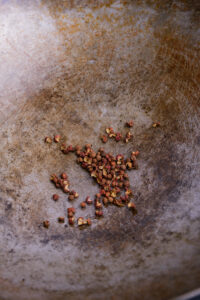
- Cut the Tofu into Approximately 1.5 cm Cubes. Blanch in Simmering Salted Water for 2-3 Minutes. Drain or Soak and Drain Just Before Use; Set Aside.
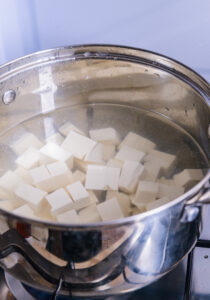
- Sauté the Minced Pork Belly in a Wok over Medium-High Heat. Break Up the Pieces with a Spatula.
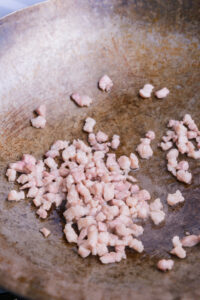
- Add the Bean Paste to the Pork.
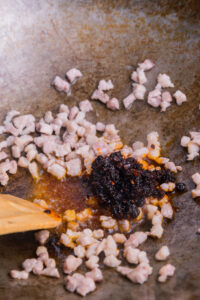
- Stir-Fry over Medium Heat Until the Oil Turns Red.
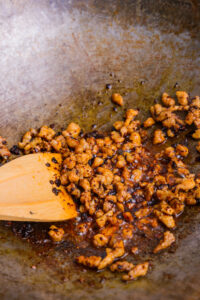
- Incorporate the Garlic and Chili Powder. Sauté for 1 Minute
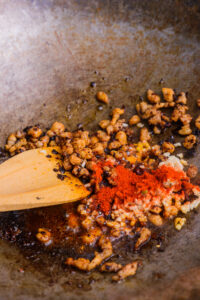
- Add the Broth, Soy Sauce, Shaoxing Wine, and Sugar. Simmer for a Few Minutes
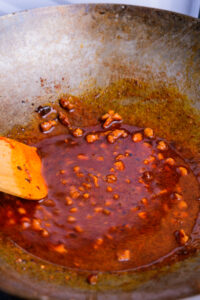
- Add the Drained Tofu. Cook over Medium-High Heat, Stirring Gently, Until the Sauce Begins to Thicken.
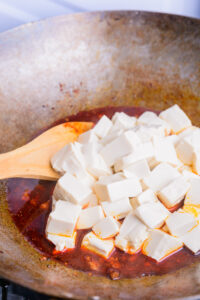
- After About 3 Minutes, It Should Start to Boil Rapidly and the Liquid Will Resemble a Thin Sauce
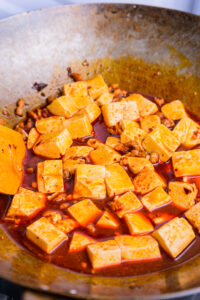
- Season with Ground Sichuan Pepper and Black Vinegar. Stir and Cook for 30 Seconds.
- Thicken with Cornstarch, Mixing Well. Turn Off the Heat, Incorporate the Toasted Sesame Oil and Gently Mix.
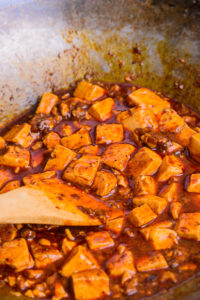
- Garnish with Green Onions to Serve
Notes
Nutrition
Culinary sources
Got most of my information for this recipe from the Chinese cooking channel “Chinese cooking demystified”. Go give it a watch, it’s a very interesting video and the overall channel is just brilliant.
